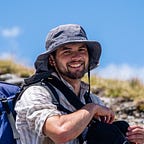Combating the Gladiator and the meaning of life
The Gladiator, a four day transalpine loop in south Westland
“What is it all for?”, a question asked by titans of the arena in the first century AD, and by a travelling middle-aged Norwegian academic armed with a high-powered crossbow that we met at Cassel Flat Hut.
But I get ahead of myself, you may be wondering why we found ourselves at Cassel Flat in the first place. Leading up to the end of 2022 we had been dreaming and scheming of a trip to a remote part of the South Island. Originally we had been set on a trip to the Olivine Ice Plateau, but for various reasons we ended up setting our sights on ‘The Gladiator’, a 2125 metre peak on the Hooker Range in south Westland. To get there we would have to follow the Karangarua River up to Cassel Flat where Tereza would meet me and Mat, before traversing high above the Douglas River to Horace Walker Hut. From there we had to cross the wild Douglas River before climbing the untamed slopes of the Gladiator and ascending to its peak.
